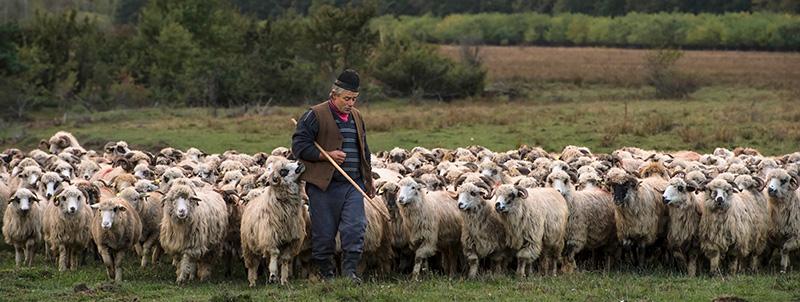
Produced in the rustic wilderness of Transylvania, Telemea de Sibiu PGI is a semi-hard cheese made from sheep’s milk. The cheese is rooted in the rolling grasslands of Sibiu county, where sheep have grazed for centuries.
The final product takes the form of dense, creamy-white blocks, which can be enjoyed both fresh and mature.
Origins
Telemea de Sibiu PGI originates from the Romanian county of Sibiu, located in the historic region of Transylvania.
The terrain of the region rises to between 250m and 2,500m above sea level and exists in a continental temperate climate. These conditions allow for the flourishing of natural grasslands with a diverse array of wild flora.

Sheep have grazed upon this land for centuries, providing a source of food, clothing and milk for local communities.
The sheep’s milk, steeped in the aromas of the wild grasses and flowers, is particularly prized by the people of the region, who developed traditions of cheese-making that have remained intact until the present day.
Telemea de Sibiu PGI is still made entirely from raw, unpasteurised milk, as was the case in the years before modern pasteurisation techniques were developed.
Most of the production process is undertaken by hand, with producers relying on traditional tools and techniques that have been passed down by previous generations.
The traditions are kept alive by the baci (a shepherd in charge of cheese-making), who oversees the production process and whose expertise and execution are key to achieving the distinctive taste and texture of the cheese. The baci is a prestigious position within the community, reflecting the importance of cheese-making to local society.
The tradition is celebrated in a large number of festivals, feasts and folk events, held across the Sibiu county every year. Festivities such as the ‘Sus pe muntele din Jina’ festival, the Cheese and Brandy Festival, and the ‘Bujorul de Munte’ festival celebrate sheep-rearing and honour Telemea de Sibiu PGI as one of the iconic products of the region.
In recognition of Telemea de Sibiu’s unique heritage, the product was awarded the protected geographical indication (PGI) status in 2019.
Production
From the raising, grazing and milking of sheep to the making and maturing of the cheese, all stages in the production of Telemea de Sibiu PGI take place in Sibiu county in Transylvania, central Romania.
The cheese is derived from the fresh, unpasteurised milk of sheep raised in the Sibiu county. The sheep graze mainly on grassland for a minimum period of 200-230 days, from April to November. In the winter, when the sheep cannot be put out to pasture, they are fed on green fodder and non-fermented farm hay, cut from the local grass.
The grassland of the region is home to flora from plant families such as poaceae, brassicaceae, apiaceae, and asteraceae. These species are rich in terpenes and sesquiterpenes, organic components whose highly aromatic odours are imparted in the sheep’s milk.

The fresh milk is brought from the dairy to the production premises, where it is prepared by the baci, the custodian of the local cheese-making traditions.
After its acidity, density, and fat content have been tested, the milk is filtered and poured into a vat, where it is heated. The milk is constantly stirred by hand in a circular motion and in a single direction, so that it does not settle and collect at the bottom of the vat.
When the milk reaches 28°-30 °C, the baci adds rennet, an enzyme used to advance the curdling process. After the rennet has been added, the milk begins to separate into curds and whey. Once again, it is stirred in a circular motion and in a single direction, before being stirred in the opposite direction for 1-2 minutes. The milk is then left to rest for 45-60 minutes, allowing the coagulation to continue.
After identifying the right point of coagulation, the baci removes the layer of curd at the top of the milk using a special scoop called a ‘telemea spoon’.
The scooped slices of curd are laid upon a receptacle lined with cheesecloth, before being cut lengthwise and crosswise with a special round-tipped knife to form uniform strips 3-4 cm wide. The curd is cut with slow and careful movements, so that it is not broken up and lost in the whey. The operation is repeated twice more, after which the blocks of curd are pressed for 30-35 minutes in order to get rid of the whey and achieve the correct consistency. At the end of this process, the blocks are 12-14 cm high.
Telemea de Sibiu PGI is sold both fresh and mature. In the latter case, the cheese must be matured for at least 21 days.
Whether fresh or mature, the final product is characterised by a subtly tangy, salty flavour, with a smooth aftertaste. Within the light scent of sheep’s milk, one can detect the aroma of mature wild grasses and hay.
More information
Telemea de Sibiu PGI – legal specifications

